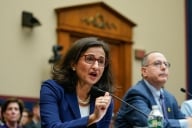You have /5 articles left.
Sign up for a free account or log in.

iStock/Getty Images Plus
The share of high school students enrolling directly in college continues to fall, data from the National Student Clearinghouse Research Center show. College enrollment by the high school Class of 2020 showed an “unprecedented” decline of between four and 10 percentage points depending on the high school category, according to the finalized version of the High School Benchmarks report released last month.
Prospects for the graduating Class of 2021 don’t appear much better; preliminary data from the clearinghouse show freshman enrollment declined 2.7 percent from last fall—13.1 percent since 2019—across all sectors except private nonprofit four-year institutions, which increased 2.5 percent over last fall. Overall postsecondary enrollment for fall 2021 is running 2.6 percent below 2020’s level, for a total 5.8 percent drop since 2019.
Continued enrollment losses among traditional college-age students, aged 18 to 24, remain “concerning,” the center noted.
Some state boards of regents are feeling the squeeze. In Arizona, a new postsecondary attainment report from the Arizona Board of Regents found that out of the 73,400 high school students who graduated in 2020, less than half—46.3 percent—enrolled in college, a steep drop from 2019, when 52.9 percent of high school graduates did.
“Arizona is not moving in the right direction on high school graduates going to college and this problem was exacerbated by the pandemic,” the report says. “This is a concern because educational attainment is a primary factor that impacts the quality of Arizona’s labor market and the state’s ability to compete regionally and nationally for high-paying employers and jobs.”
The decrease in enrollment mostly hit Arizona’s two-year institutions, which saw a 6.1-percentage-point decrease year over year; four-year enrollment held “relatively steady” at 28.3 percent of high school graduates, according to the report.
Data from the University of Wisconsin system show there were 1,710 fewer new first-year, full-time-equivalent students in 2020 compared to 2019. In Ohio, the number of public high school graduates enrolling in a public institution peaked in 2018 at 51,075 students and declined 4 percent to 48,451 in 2020. The Kansas Board of Regents shows enrollment for first-time entering students declining from 16 percent in fall 2019 to 14 percent in fall 2021.
According to the latest High School Benchmarks report, the enrollment decline among 2020 high school graduates disproportionately affected students from low-income schools, who enrolled at a rate of 49 percent; by comparison, 65 percent of higher-income high school graduates immediately enrolled in college.
At high-poverty schools, the immediate enrollment rate fell from 55 percent to 45 percent between 2019 and 2020, the report found.
Anthony Carnevale, director of the Georgetown University Center on Education and the Workforce, noted that some low-income students may be deterred from going to college by the physical risks of COVID-19, while others have had a hard time finding jobs during the pandemic, leaving them unable to afford college.
“Most people who are in the lower half of the family income distribution, you can’t work your way through college anymore. It’s too expensive,” Carnevale said. “But you do need a job. And so when the jobs go away, that screws up going to college, which is what’s unique about COVID.”
Carnevale said that applications for the top 200 colleges in the U.S. have actually risen; the decline in enrollment is mostly hurting two-year colleges and nonselective four-year colleges, where low-income and minority students are concentrated.
The High School Benchmarks report found that students from high schools with fewer minority students were 12 percentage points more likely to enroll immediately in college than those from high schools with higher minority populations—64 percent versus 52 percent.
Will Patch, senior enrollment insights leader at Niche, a company that connects people to institutions, neighborhoods and workplaces, said surveys from his organization showed that Native students, first-generation students and low-income students were more likely than other groups to say they weren’t planning to attend college. Students who identified as nonbinary or other-gendered were about three times as likely to say that they weren’t enrolling in college as students who identified as male or female—perhaps because those students had less family or financial support, he said.
“What I’m piecing together here from these surveys is really the groups who were already struggling are also the ones who are forgoing college,” Patch said. “I think there’s these hopes and finger-crossing going on that they will enroll later. But I think anyone who’s worked long enough with students, if a student doesn’t enroll that first year, they’re much less likely to come back later.”
Patch said students have a lot of hesitancy about enrolling because of shifting COVID-19 protocols—especially now, with a lot of institutions starting their spring semesters remotely due to the Omicron variant surge. Misinformation also plays a role in shrinking college enrollment, he noted; some students are confused about the evolving SAT and ACT requirements, and others fail to cast a wide enough net when applying, often sticking to institutions with high name recognition.
Only 20 percent of students surveyed said they’d considered enrolling in community college, Patch said, which he finds odd.
“If students have this financial instability, they may not quite know what they want to do next,” he said. “It seems like it should be another big time for community colleges, where students can get their start … So it’s surprising to me that so few said that they’re interested in that.”
Enrollment rates at community colleges continue to plummet across the country, forcing some institutions to reduce their operating budgets over worries about larger economic repercussions.
Patch said many high school graduates are more interested in taking jobs at restaurants and other establishments where pay runs $15 per hour with benefits.
“Before coming to higher ed, I was a secondary teacher, and $15 an hour is about what I was paid,” Patch said. “If I go work at Taco Bell, I could make about as much as I could teaching. And one of those doesn’t require a four-year degree. So how do you compete with that? How do you attract people to these very needed professions—social workers, teachers—that are not really valued financially in the same way?”
Carnevale noted that with more high school graduates opting to go straight to work, the U.S. could face a skills shortage in the future, which employers and politicians will need to address.
“There’s a debate going on that once the economy recovers, there’s going to be skill shortages all over the place, because people aren’t going to college,” Carnevale said. “And because the retirement rate has gone up dramatically with COVID, with baby boomers, the skill-shortage story may be real.”
Pre-pandemic data from his center showed that 22 percent of jobs held by workers with less than a high school diploma were “good jobs,” he said, meaning they pay at least $45,000 a year by midcareer; by contrast, 40 percent of jobs held by workers with a high school diploma and 48 percent of jobs held by workers with some college but no degree met that criterion.
Carnevale predicted that by 2031, there will likely be about 35 million job openings, of which 30 percent will be available to high school graduates, 30 percent will be middle-skill jobs that require more than a high school diploma but less than a bachelor’s degree and 40 percent will demand a bachelor’s or graduate degree.
Patch noted that the wave of high school graduates choosing work over college could lead to a big push in 15 or 20 years for more adult education, drawing an influx of people who have some technical training and can fill lower-salaried positions but aren’t ready for higher-level jobs.
“I really hope that students go back to college sooner rather than later,” Patch said. “I hope we have these part-time pathways or other options to bring students back in a way that’s going to help them thrive. I think there are a lot of ways to go, but I just hope it happens fast, rather than waiting until it becomes a problem.”








